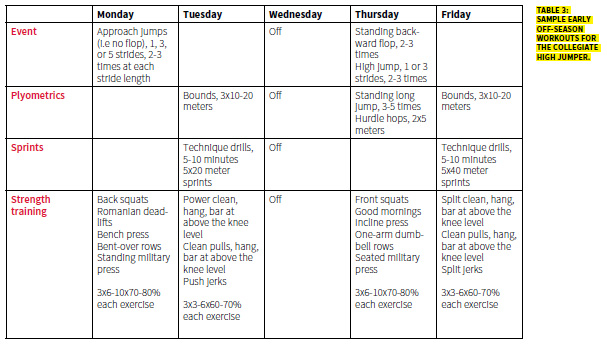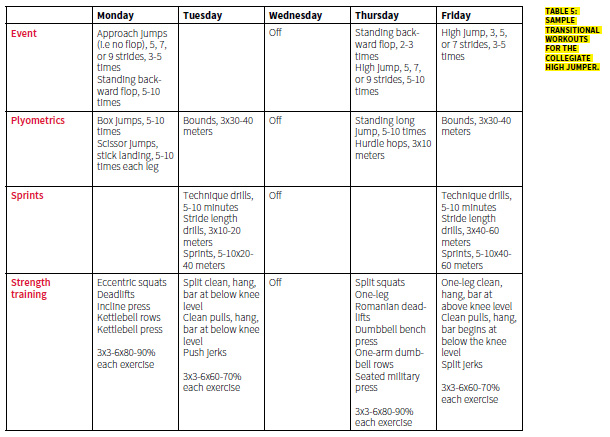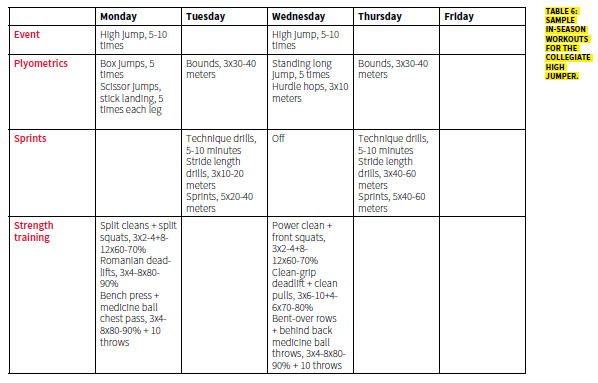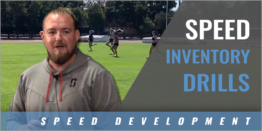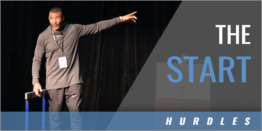|
By: John Cissik Originally Published in: Techniques Magazine Provided by: USTFCCCA
The high jump is an extremely technical event in track and field, which can make designing a strength and conditioning (S&C) program for these athletes difficult. Currently, there is a lack of literature on designing S&C programs for high jumpers. This article will describe the high jump, cover the S&C needs of the high jumper, explain how these athletes are trained in their sport, and present recommendations for S&C programming. ANALYSIS OF THE HIGH JUMP The high jump consists of three phases. These phases are the approach phase, the plant/takeoff phase, and the flight phase. APPROACH The approach begins as a straight line sprint that eventually turns into a curve. Most athletes have an approach run that covers eight to twelve strides. The approach run is extremely important for performance in the high jump (3, 13, 21),It increases the athlete's horizontal velocity, which will eventually be used for the plant. It also places athletes in a good takeoff position so that they can achieve an optimal angle for takeoff at the greatest take-off velocity possible (23). Some athletes may achieve velocities of 6-8 m/s during the approach run (16, 24). PLANT/TAKEOFF During the plant/takeoff, the horizontal velocity that has been developed during the approach run is used to develop the vertical velocity that will be required to jump high. Some authors consider this to be the most important phase in the high jump (10).This phase is very short (around 0.18 seconds) and during this phase, the athlete may achieve vertical velocities of up to four meters per second (3, 16). The plant and takeoff begin during the approach. The athlete's second-to-last stride during the approach run (called the penultimate stride) will be longer than the last stride and will begin the lowering of the athlete's center of gravity by flexing the knee. During the last stride, the foot is slapped down and the knee is extended. The athlete is leaning backwards so that the hips are ahead of the shoulders. The leg during the last stride acts as a lever while the other leg is swung forward and up allowing the athlete to jump (23). FLIGHT Success in the flight phase is dependent by the athlete's ability to exert force against the ground during the plant/takeoff (11, 13, 24). The athlete must achieve a high enough horizontal velocity during the approach, keep an extended leg during the plant, and achieve full extension during the takeoff (13, 21). The plant and takeoff take place in front of the bars so that the athlete can jump backwards over the bar. This means that as the athlete leaves the ground during the takeoff, they must make sure their body is out of the way of the bar while they pass over it. This is done by arching the back after the head and shoulders have cleared the bar, which lifts the hips. S&C NEEDS A S&C program has two purposes for the high jumper. The first is to provide the physical foundation for success in the event. The second is to help prevent injuries (21). With the above analysis in mind, there are a number of qualities that are going to be important for the S&C of the high jumper.
High jumpers need to be able to propel themselves along the track with enough velocity to eventually attain height in the jump. They must also be able to overcome gravity during the jump. Both of these aspects of the jump require a measure of strength on the part of the high jumper (7, 21). It should be noted that not only S&C coaches consider this quality to be important, high jump coaches consider its importance but also stress the importance of being able to apply it to the event (4, 21). POWER As was covered earlier in this paper, the high jump requires that force be exerted quickly during the jump. With the plant and take-off taking fractions of a second, the ability to exert force quickly is extremely important to the high jumper (21). The fraction of a second that the plant/take-off takes aligns very well with the length of the second pull in the Olympic lifts (1, 14, 15). HORIZONTAL APPLICATION OF FORCE The ability to exert force in the horizontal direction is potentially going to be important for an athlete whose event requires generating horizontal velocity. Several studies hint at a relationship between the ability to perform horizontal jumps and sprinting speed (1, 12).Weyand et al (26) reported that athletes increase their speed by exerting more force against the ground rather than by repositioning their limbs more quickly.If this is true, then it reinforces the benefit that a S&C program can have to the approach run of the high jump. By improving a high jumper's strength, power, and their ability to apply force horizontally there is the potential to improve their running velocity. SINGLE LEG STRENGTH AND POWER Sprinting involves having one foot on the ground at a time. The plant and takeoff involve levering off one side of the body and exploding vertically. The combination of these suggests that high jumpers need to develop single-leg strength and power. ABILITY TO MAINTAIN POSTURE Sprinting and a successful lever require that the athlete is strong enough to maintain his or her posture, this reinforces the need for a strength base (5, 7, 22). Failure to maintain posture either during sprinting or the plant can have a negative impact on velocity and eventually the height of the jump.
HAMSTRING INJURY PREVENTION As horizontal velocity is important for the high jumper, sprinting will be an important component of their training program. Sprinting athletes are at risk for hamstring injuries. Studies examining the hamstrings during sprinting suggest that the biceps femoris is especially susceptible to strains when the leg is being swung forward or during footstrike, as these are times when the muscle is lengthened. This suggests that it is important to strengthen the hamstring muscles eccentrically (17, 19). Table one provides examples of exercises that can be used to address each of the above qualities. The rest of this article will provide a sample strength and conditioning program for a collegiate high jumper. The rest of this article will provide an overview to a high jumper's event-specific training, discuss how the training year is organized, then provide a sample training program for the collegiate high jumper.
EVENT-SPECIFIC TRAINING Event-specific training for the high jumper focuses on several parts. These include sprint training, breaking the event into components, performing the full event with run-ups of varying distances, and plyometrics (4, 5, 21, 22, 23).
OVERVIEW OF THE YEAR Before covering the program, it's important to explain how the high jumper's year is organized at the macro level.In this article, the high jumper's training year will be broken down into competition, off-season, and recovery. For a collegiate high jumper, there are often two competition seasons: an indoor season that typically runs from January until mid-March and an outdoor season that typically runs from mid-March and can last until the end of June if the athlete participates in Collegiate and Outdoor Nationals. As a result, January through June makes up the athlete's competition phase of training. The National Collegiate Athletics Association (NCAA) does not allow practices to begin until the first day of fall classes or September 7, whichever is earlier (18). Therefore, this is when the off-season begins. The off-season runs through the holidays. There is one transitional phase of training that is used with this calendar. This occurs during the month of January. While the athlete will be competing during that month in indoor meets, these do not carry the importance of the later meets. Therefore, this month is a transitional phase between the off-season training and the competition season training. Table two provides a graphical overview of the collegiate high jumper's season, using 2016/2017 dates. SAMPLE TRAINING PROGRAM The rest of this article will describe the S&C programs that the author uses to train collegiate high jumpers, based on the above. The programs are presented with event-specific training to illustrate how the S&C training can be used to complement the athlete's event training. A word about notations used in the tables:
Strength training is written as the number of sets times the number of repetitions times the percentage of the athlete's one-repetition maximum (or it shows the repetition range at which the athlete should be lifting). OFF-SEASON The off-season develops the physical and technical foundation necessary for success later in the year. Tables three and four provide sample training programs for the off-season. Table three illustrates the kind of workouts that would run into October and table four the workouts that would run through December. These tables are meant to provide examples; the training variables would change from week to week in a real program. The training is organized around two jumping days, two sprinting days, and a day off in the middle of the week.
The jumping days (Monday and Thursday in this example) begin with a warm-up.After the warm-up, the athlete practices the event. At the beginning of the season, this works on the phases in isolation and with a smaller (1, 3, or 5 strides) approach run. This allows the athlete to perfect his or her technique at low velocities. Plyometrics follow the event training and are meant to compliment the event workouts. During the jumping days, strength training workouts follow the jump training and are focused on slower, multi-joint exercises designed to increase the athlete's strength. The idea is that the heavier training will complement the nervous system demands made by the event practice and plyometrics. The sprinting days (Tuesday and Friday in this example) also begin with a warm-up. After this, the athlete moves to bounds to help with sprinting speed, sprinting technique drills, and then sprints that are focused on either acceleration or maximum velocity. The strength training work is focused around the Olympic-style lifts, whose explosive and low volume nature should complement the demands of the sprinting workouts. As the off-season progresses, the volume of the strength training decreases while TRANSITION The demands of the technical training increase as the focus shifts to meet The first transition phase will run into the indoor season in January if time permits. It is not unusual for a jumper to train through the first few meets and use them as warm-up meets. Table five provides a sample of pre-season workouts.
COMPETITION The competition phase for a collegiate high jumper runs from January until they are done with competition (which could be June for a national-caliber jumper or July for an international-caliber jumper). Track and field competition involves a lot of travel, and the ideal circumstances for training may or may not exist during the season. With this in mind, there is a need to maximize the athlete's limited training time. Strength training focuses on maintenance. Because time is precious, extensive use intensity and volume is meant to maintain strength and power during this phase. Event training puts the entire event together and practices Speed training seeks to maintain the ability to accelerate and achieve a high maximum velocity.If possible, it will be performed twice a week and on non-jumping days. Plyometrics will still Table six shows an example of in-season training for the high jumper. CONCLUSION The high jump is a complex track and field event that requires a unique balance between strength, speed, power, and technique. Athletes must be able to achieve horizontal velocity, convert it to vertical velocity to overcome gravity, and must do all this with optimal technique. REFERENCES: Agar-Newman, D.J. and Klimstra, M.D. (2015). Efficacy of horizontal jumping tasks as a method for talent identification of female rugby players. Journal of Strength and Conditioning Research 29(3): 737-743, 2015 Akkus, H. Kinematic analysis of the snatch lift with elite female weightlifters during the 2010 world weightlifting championship. Journal of Strength and Conditioning Research 26(4): 897-905, 2012 Aura, 0. and Viitasalo, Bora, P.Direct competition preparation in elite high jumping. New Studies in Athletics 27:3, 23-28, 2012. Bowerman, W.J. and Freeman, W.H. High-Performance Training for Track and Field 2nd edition. Champaign, Il: Leisure Press, 127-138, 1991. Cissik, J.M.Strength and conditioning considerations for the 100 meter sprinter.Strength and Conditioning Journal 32(6): 89-94. Cissik, J.M. Strength and conditioning for the high jump. Modern Athlete and Coach 52(4): 18-21, 2014. Cissik, J.M.Strength and conditioning for the triple jumper. Strength and Conditioning Journal 35(5): 56-62. Cissik, J.M.Strength and Conditioning for Track and Field.Mountain View, CA: TAFNEWS.2003. Coh, M.Biomechanical characteristics of take off action Dapena, J.Contributions of angular momentum and catting to the twist rotation in high jumping.Journal of Applied Biomechanics 13: 239-253, 1997. Dobbs, C.W., Gill, ND., Smart, DJ, and McGuigan, M.R. (2015). Relationship between vertical and horizontal jump variables and muscular performance in athletes. Journal of Strength and Conditioning Research 29(3): 661-671. Grieg, M.P. and Yeadon, M.R. The influence of touchdown parameters on the performance of a high jumper.Journal of Applied Biomechanics 16: 367378, 2000. Hadi, G., Akkus, H., and Harbili, E.Three-dimensional kinematic analysis of the snatch technique for lifting different barbell weights. Journal of Strength and Conditioning Research 26(6): 1568-1576, 2012. Harbili, E. A gender-based kinematic and kinetic analysis of the snatch lift in elite weightlifters in 69-kg category. Journal of Sports Science and Medicine 11: 162-169, 2012. Isolehto, I., Virmavirta, M, Kyrolainen, H., and Komi, P.Biomechanical analysis of the high jump at the 2005 IAAF World Kumazaki, T., Ehara, Y, and Sakai, T. Anatomy and physiology of hamstring injury. International Journal of Sports Medicine 33(12): 950-954, 2012. National Collegiate Athletic Association. Division I Manual lndianapolis, IN: 276279, 2016. Opar, D.A., Williams, MD., and Shield, A.J.Hamstring strain injuries: Factors that lead to injury and re-injury. Sports Medicine 42(3): 209-226, 2012 Reid, P. Plyometrics and the high jump. New Studies in Athletics 4:1, 67-74, 1989. Ritzdotf, W. Approaches to technique and technical training in the high jump.New Studies in Athletics 24(3): 31-34, 2009. Schiffer, J.Plyometric training and the high jump. New Studies in Athletics 27:3, 9-21, 2012. Schmolinsky, G.Track and Field: The East German Textbook of Athletics.Toronto, Ontario: Sport Books Publisher, 262-292, 1996. Tan, J.C.C. and Yeadon, M.R. Why do high jumpers use a curved approach?Journal of Sport Sciences 23(8): 775-780, 2005. Urquhart, B.G., Moir, G.L., Graham, S.M., and Connaboy, C.Reliability of 1Rm split-squat performance and the efficacy of assessing both bilateral squat and split-squat 1RM in a single session for nonresistance-trained recreationally active men.Journal of Strength and Conditioning Research 29(7): 1991-1998, 2015. Weyand, P.G., Sternlight, D.B., Bellizzi, M.J., and Wright, S.Faster top running speeds are achieved with greater ground forces not more rapid leg movements. Journal of Applied Physiology 89(5): 19911999. JOHN CISSIK IS THE PRESIDENT AND OWNER OF HUMAN PERFORMANCE SERVICES, LLC (HPS), WHICH HELPS ATHLETICS PROFESSIONALS SOLVE THEIR STRENGTH AND CONDITIONING |







